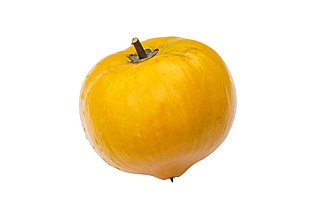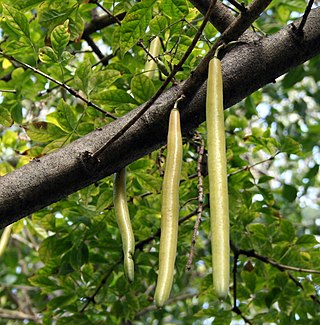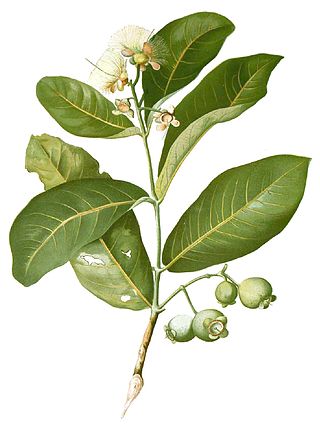
Kumquats, or cumquats in Australian English, are a group of small fruit-bearing trees in the flowering plant family Rutaceae. Their taxonomy is disputed. They were previously classified as forming the now-historical genus Fortunella or placed within Citrus, sensu lato. Different classifications have alternatively assigned them to anywhere from a single species, C. japonica, to numerous species representing each cultivar. Recent genomic analysis would define three pure species, Citrus hindsii, C. margarita and C. crassifolia, with C. x japonica being a hybrid of the last two.

Tamarind is a leguminous tree bearing edible fruit that is probably indigenous to tropical Africa. The genus Tamarindus is monotypic, meaning that it contains only this species. It belongs to the family Fabaceae.

Jujube, sometimes jujuba, known by the scientific name Ziziphus jujuba and also called red date, Chinese date, and Chinese jujube, is a species in the genus Ziziphus in the buckthorn family Rhamnaceae.

Syzygium samarangense is a species of flowering plant in the family Myrtaceae, native to an area that includes the Greater Sunda Islands, Malay Peninsula, and the Andaman and Nicobar Islands, but introduced in prehistoric times to a wider area and now widely cultivated in the tropics. Common names in English include wax apple, Java apple, Semarang rose-apple, and wax jambu.

Calophyllum inophyllum is a large evergreen plant, commonly called tamanu, oil-nut, mastwood, beach calophyllum or beautyleaf. It is native to tropical Asia and Wallacea. Due to its importance as a source of timber for the traditional shipbuilding of large outrigger ships, it has been spread in prehistoric times by the migrations of the Austronesian peoples to the islands of Oceania and Madagascar, along with other members of the genus Calophyllum. It has since been naturalized in regions in the East African coast. It is also a source of the culturally important tamanu oil.

Pouteria campechiana is an evergreen tree native to, and cultivated in, southern Mexico, Belize, Guatemala, and El Salvador. It is cultivated in other countries, such as India, Costa Rica, Brazil, the United States, the Dominican Republic, Australia, Cambodia, Vietnam, Indonesia, Sri Lanka, Nigeria, and the Philippines. The edible part of the tree is its fruit, which is colloquially known as an egg fruit.

Parmentiera cereifera, the candle tree, is a species of tree in the family Bignoniaceae. It is endemic to Panama, but it is also a commonly cultivated specimen in botanical gardens.

Prunus maritima, the beach plum, is a species of plum native to the East Coast of the United States. It is a choice wild edible and its few pests and salt tolerance make it a resilient fruit crop for degraded lands and urban soils.

Spondias purpura is a species of flowering plant in the cashew family, Anacardiaceae, that is native to tropical regions of the Americas, from Mexico to Brazil. It is also very common in most of the Caribbean islands. It is commonly known as jocote, which derives from the Nahuatl word xocotl, meaning any kind of sour or acidic fruit. Other common names include red mombin, plum, purple mombin, hog plum, ciriguela, ceriguela, seriguela, siriguela (Brazil) cocota, ciruela huesito (Colombia), ciruela, ciruela traqueadora (Panama), ciriguela, cirigüela, cirguela, cirguelo (Ecuador), makapruim, and siniguelas (Philippines). It is a popular fruit throughout Central America, particularly in El Salvador, Nicaragua, Honduras and in Costa Rica.

Syzygium aqueum is a species of brush cherry tree. Its common names include watery rose apple, water apple and bell fruit, and jambu in several Indian languages.

Chaenomeles japonica, called the Japanese quince or Maule's quince, is a species of flowering quince that is native to Japan.

Crataegus crus-galli is a species of hawthorn known by the common names cockspur hawthorn and cockspur thorn. It is native to eastern North America from Ontario to Texas to Florida, and it is widely used in horticulture. It is thought to be the parent, along with Crataegus succulenta, of the tetraploid species Crataegus persimilis.

Flacourtia jangomas, the Indian coffee plum, or scramberry, is a lowland and mountain rain forest tree in the family Salicaceae. It is widely cultivated in Southeast and East Asia, and has escaped cultivation in a number of places. Its wild origin is unknown but is speculated to be tropical Asia, most perhaps India. This tree is very common in the Southern India and is of culinary and medical importance, especially in Kerala where it is commonly known as lubikka or lololikka. Fruits are eaten both raw and cooked as a jam or pickes, and the bark is sometimes used medicinally. It is sometimes harvested for its lumber. The plant is considered one of the primary host plants of the Queensland fruit fly

Musa acuminata is a species of banana native to Southern Asia, its range comprising the Indian Subcontinent and Southeast Asia. Many of the modern edible dessert bananas are from this species, although some are hybrids with Musa balbisiana. First cultivated by humans around 10 kya, it is one of the early examples of domesticated plants.

Flacourtia indica, known commonly as ramontchi, governor's plum, Madagascar plum and Indian plum, is a species of flowering plant native to much of Africa and tropical and temperate parts of Asia. F. indica and F. ramontchi are sometimes treated as separate species.

Flacourtia inermis, known commonly as lovi-lovi, or batoko plum, is a species of flowering plant native to the Philippines and Indonesia, but which has naturalized around the edges of tropical Asia and Africa. Common names in Indonesia include Tome-Tome, Lovi-lovi, and lobi-lobi.

Adenia globosa is a species of flowering plant in the passionflower family, Passifloraceae. It is native to tropical Africa, where it occurs in Ethiopia, Kenya, Somalia, and Tanzania. It is known as mpaga in Swahili.

Pouteria viridis is a species of flowering plant in the family Sapotaceae known by the common name green sapote.

One of the major human migration events was the maritime settlement of the islands of the Indo-Pacific by the Austronesian peoples, believed to have started from at least 5,500 to 4,000 BP. These migrations were accompanied by a set of domesticated, semi-domesticated, and commensal plants and animals transported via outrigger ships and catamarans that enabled early Austronesians to thrive in the islands of Maritime Southeast Asia, Near Oceania (Melanesia), Remote Oceania, Madagascar, and the Comoros Islands.

Pandanus dubius, commonly known as bakong or knob-fruited screwpine, is a species of Pandanus (screwpine) native to Island Southeast Asia, New Guinea, and the Western Pacific islands, and possibly also to the Andaman and Nicobar Islands.




















